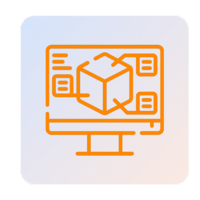Embedded Software Development Services
Embitel is at the forefront of innovation, delivering cutting-edge, custom embedded software. Embedded software developed by Embitel’s team of experts have actively served at the heart of modern devices in the Automotive, EV, Industrial, Medical, and Energy sector.
With expertise in a wide range of tools required to develop timeless embedded software, let us handpick the most appropriate tech stack for your business requirements.
To get started, contact our embedded software consultants here!
Our Embedded Software Development Endeavours: Success Stories
Embedded Software Development v/s Firmware Development
Embedded software development and firmware development are often used interchangeably, but they are not the same. Simply put, firmware development is a crucial subset of the broader activities involved in embedded software development.
Our Services
Embedded Software Development Services
- Linux-Based Development: We specialize in crafting embedded Linux services tailored for a variety of microprocessor architectures such as Renesas, ARM, AVR, and Cortex.
-
Android-Based Development: Our team’s Android services offer comprehensive app control
and grant advanced access to system resources akin to “root”
privileges, along with automation tools for device deployment.
We assist manufacturers of industrial products to develop embedded software to establish connectivity with third-party devices and facilitate Android integration.
Our in-house experts develop custom software architecture, based on the OS to maximize the embedded software for the application of your choice.


Embedded Firmware Development Services
- RTOS Programming : Our team excels in crafting embedded firmware for real-time applications, utilizing top RTOS platforms like FreeRTOS, ThreadX, and more. We ensure swift system responses and tailored solutions for diverse industries.
- Non-OS based (Bare Metal) Embedded Firmware: Our team designs bare-metal firmware for embedded devices, ensuring continuous task execution without relying on operating systems.
This approach optimizes resource control, lowers costs, and guarantees compliance with specifications.
Partner with us for reliable, responsive firmware solutions.
Firmware-Over-The-Air (FOTA) Services
-
Hardware & Software Development Services
: To meet your FOTA needs, we select the best flash memory and
integrate it with Wi-Fi, Bluetooth, GPRS, and GSM modules. We
use MQTT and CoAP protocols for firmware design and secure
data exchange via HTTPS, SSL, and FTP/FTPS.
We ensure firmware update integrity with encryption and offer consultation on the required update level, whether system, OS/application, or application-only. -
FOTA Design, Development, and Testing: We develop bootloaders and
FOTA update
interfaces, offering tracking, reporting, and rollback
mechanisms. Our automated test frameworks enable devices to
perform self-tests and send post-update status reports.
Post-development, we test embedded software and hardware with pre-production scenarios to ensure reliable power, communication, and firmware updates, addressing corrupt memory and flashing errors.


HMI Development
We offer Multi-platform HMI Frameworks for web, desktop, mobile, and embedded devices. Additionally, we provide 3D HMI for Automotive with digital cockpits and virtual testing environments. Our services include development of Multi-Modal Interfaces with voice and gesture controls. The operator-centric UI/UX featuring custom controls and multilingual support help us craft a personalized user experience. We have expertise in 3D Graphics, and Localization Features too!
With globally deployed teams, we ensure full-cycle HMI implementation for enhanced user experience and operational efficiency.
Board Support Package Services
- Device Driver and Hardware Abstraction Layer Development: Our services cover both Device Driver Development and Hardware Abstraction Layer Development for embedded systems. Device drivers support diverse peripherals like USB, GPS, and touchscreen interfaces, enabling communication with the OS Kernel.Meanwhile, our Hardware Abstraction Layer includes routines for initialization, interrupt handling, and security algorithms, ensuring robust performance and scalability for custom hardware requirements.
-
Porting, Migration, and Safety Solutions:
Our services include Android and Linux BSP Porting to custom
hardware platforms, ensuring seamless integration and complete
BSP functionality. We conduct rigorous testing to ensure
bug-free code.
In addition to this, our Safety Layer Services features automotive safety diagnostics stacks such as software stacks (UDS/J1939/KWP2000/OBD II), safety module development, ECU state management, and fault code memory for comprehensive system safety and diagnostics.

Our Embedded Software Development Expert Skillsets
Here are the skills our experts bring to the table for developing embedded software:
- Embedded Systems Proficiency: We understand hardware-software interactions and constraints inherent in embedded systems.
- C/C++ Expertise: Our experts are proficient in low-level programming languages like C/C++ and high-level programming languages, enabling efficient software development for embedded platforms.
- Hardware Familiarity: We are well-versed in microcontrollers, sensors, and peripherals, facilitating seamless integration of software with hardware components.
- RTOS Expertise: We are experienced in Real-Time Operating Systems (RTOS) for precise management of real-time tasks in embedded applications.
- Linux and Android OS Expertise : Our experts are proficient in developing Board Support Packages (BSP), Middleware, and Applications for embedded devices running on Linux and Android Operating Systems.
- Security : We integrate secure boot mechanisms, and firmware integrity verification to fortify embedded systems against security threats.
- Debugging: : We possess strong debugging skills to diagnose and troubleshoot hardware and software issues effectively.
- Version Control: Our experts effectively track changes made in the code and other embedded software essentials using version control such as Git. This enables collaborative firmware development with integrity and efficiency.
Standards We Follow to Develop Secure Embedded Software
As an Embedded Software Development service provider, we ensure your project requirements are met using the following standards:
Coding Standards for Embedded Software Development: Misra C and Misra C++
Safety Standards: Functional safety (ISO 26262) and automotive cybersecurity (ISO 21434)
Apart from the above-mentioned standards, we also comply with industry-specific requirements based on the project.
Technology Stack for Embedded Software Development
Integrated Development Environments (IDEs)
We utilize platforms like Keil, MPLAB, and Eclipse, providing robust environments for firmware development with features tailored to embedded systems.

Compilers and Toolchains
Our toolkit includes GCC, Keil, and IAR Systems, enabling seamless compilation of firmware code across various architectures and platforms.

Debugging Tools
We employ a range of hardware and software debugging tools such as JTAG debuggers, oscilloscopes, and logic analyzers, ensuring thorough hardware/software debugging for robust system performance.

Version Control Systems
Git and SVN are integral to our workflow, enabling efficient management of firmware source code, version tracking, and seamless collaboration among team members.

Simulation Software
Before deployment, we utilize simulation software like Proteus and LTSpice to simulate firmware behaviour, enabling thorough testing and validation in a virtual environment.

RTOS
Our expertise extends to real-time operating systems such as FreeRTOS, uC/OS-II, and ThreadX, empowering us to develop responsive and reliable firmware for time-critical applications.

Security Tools
We employ a range of security tools including static code analysis tools and cryptographic libraries to ensure the integrity and security of firmware, safeguarding against potential vulnerabilities and threats.
Knowledge bytes
What is Firmware Development?
A Firmware is a low-level program, or a microcode hardcoded on a single-purpose device to facilitate low-level hardware interactions. Firmware supplies the necessary directions for hardware to initiate and carry out essential input/output functions. In an Embedded System, firmware is responsible for hardware modules to talk to each other.
The most common interactions facilitated by firmware can be witnessed in cameras, network cards, IoT sensors, printers, routers, scanners, and television remotes.
What is Embedded Software Development?
Developing embedded software complements firmware by controlling higher-level functions such as data processing and interaction with external devices.
While firmware manages low-level hardware interactions, embedded software oversees broader device functionality, including user interaction and system integration.

Figure 1: Embedded Software Development Hierarchy
Together, embedded software and firmware form a cohesive system, ensuring an embedded system’s seamless and reliable operation across diverse applications.
Frequently Asked Questions about Embedded Software Development
While developing software for an embedded device, Embitel’s team of experts can collaborate efficiently and effectively using the below-mentioned version control techniques:
- Local Version Control System: It operates by keeping a database on your computer, where each file change is saved as an incremental patch. These patches only record the modifications made since the last version. To view a file’s state at any point in time, you must sequentially apply all relevant patches up to that moment.
- Centralized Version Control System: This system relies on a single server to store all file versions. This setup allows multiple clients to access, download, and upload files to the server simultaneously. As a result, team members can stay updated on each other’s progress. Administrators can manage permissions, controlling access and actions for different users.
-
Distributed Version Control System (DVCS): This system offers significant advantages over local and centralized systems. Unlike the centralized model, where clients only check out the latest snapshot from the server, this system allows clients to fully mirror the entire repository, including its complete history.
This means that each collaborator has a full local copy of the project, making them less dependent on the central server.
If the central server becomes unavailable or fails, any client repository can restore the project’s version to other clients or back to the server once it’s operational. This resilience ensures that as long as one correct copy exists, the project can be quickly and easily restored and distributed.
Git, the most popular DVCS and one of our proficiencies, exemplifies these benefits. It provides robust, reliable, and flexible version control that supports seamless collaboration and ensures data integrity.
The processes involved in embedded software development life cycle (SDLC) are as follows:
- Requirements Analysis and Planning: Gather and document functional and non-functional requirements from stakeholders; formalize these in a specification document; create a project plan covering scope, timelines, resources, and budget.
- System Design: Define high-level architecture and detailed module designs, including data structures, algorithms, and interfaces.
- Implementation: Write and document source code, ensuring adherence to standards.
- Testing: Conduct unit, integration, and system testing to verify the functionality of the embedded software.
- Verification and Validation: Ensure the software meets design specifications, industry-specific compliance requirements, and user needs.
- Integration and Deployment: Load software onto hardware, configure, and test in the target environment to simulate embedded software’s performance in real-life scenarios.
- Maintenance and Updates: Fix bugs, release updates, and provide long-term support.
- Documentation: Maintain design documents and user manuals.
- End-of-Life: Plan product retirement and disposal.
Innovators that wish to partner with an embedded software development company must look out for the following –
- A dedicated team to guide you to the best technology stack and meet your project needs!
- Continuous testing and verification of the embedded software to mitigate and eliminate the likeliness of critical errors emerging after the full deployment of the custom embedded solution.
- As an embedded device application is not limited to a single industry, you should partner with a company that has expertise in meeting industry-specific compliance metrics.
- An advantage of embedded software is its ability to constantly evolve. Your embedded software provider must offer post-deployment support in the long-run. Partners who are proactive in upkeeping the software with the latest advancements, making them risk-averse and scalable are the ones to look for.
- Following the embedded software development life cycle makes the solution cost-effective by detecting the defects early, resolving them and avoiding rework at the later stages.





